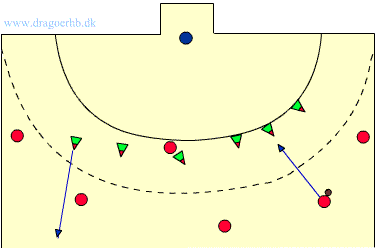Fast break - When does the wing start
|
|

|
|
|
|
In order to obtain a good lead in the fast break, you must be willing to take
a chance and also be willing to run in vain several times.
In this example
it is the wings, who have received the task to be the fast break starters (which
is quite normal).
The wings must have great attention to shooting attempts
made on the opposite side, and when they see, that the opposite wing or backcourt
make an attack which could lead to a shot, they must move forward against the
9-meter throw line.
If the shot is made, they start the fast break, but must
still keep an eye on the result of the shot.
.
Advantages
The
situations, where the
wing can receive a pass and run against the opponent's goal:
The shot is
blocked and the defending team gets the ball. The running continues.
The
goalkeeper block the shot and is able to get control of the ball fast. The running
continues.
Disadvantages
The situations where the wing runs in vain:
The shot is
blocked and the opponents get control of the ball. Quick return.
The goalkeeper
blocks the shot, but cannot get control of the ball quickly. The running continues,
but in a calm speed.
The opponents scores.
Risks:
The shot is blocked
by the defense or the goalkeeper, but rolls to the area, where the running wing
should have been. Here the opponents can pick up the ball and shoot.
The
shot is blocked by the defense or the goalkeeper and the opponents get control
of the ball and makes a pressure against the empty wing area.
Looking
at the advantages it should be very clear: A free run with the ball against
the opponent's goal.
Looking at the risk there are many other places
that the ball could end than in the empty wing space. And should the opponents
get control of the ball, they will only have a brief moment of number majority.
The disadvantages are a part of the game, where a player often runs in vain.
But if this is not done, the play will be stationary and minimize the chances.
 |
|

